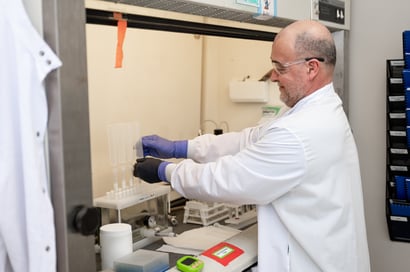On February 14th, Nick Nigro, Pace® PFAS Product Manager, along with other leaders of ASTM subcommittee F15.81 on Per-and Polyfluoroalkyl Substances, held a webinar discussing the what, why, and how of quantifying PFAS in Consumer and Related Products. Among many topics, the team addressed the challenge created by the varying definitions of PFAS used by the states when crafting legislation. This comes up frequently in conversations with our manufacturing customers, so I wanted to share some of the highlights from the webinar.
Watch: Quantifying PFAS in Consumer and Related Products: The Latest Developments
What a Difference a Definition Makes!
Although PFAS were first discovered in the 1940s, it wasn’t until 2011 that most scientists and regulators began thinking of them as a class of synthetic compounds. That’s when the attempts to define PFAS began in earnest. Over the years, three primary organizations have proposed working definitions of PFAS: Buck et al., the OECD, and the U.S. EPA.
Buck et al. – In a seminal paper titled "Perfluoroalkyl and Polyfluoroalkyl Substances in the Environment: Terminology, Classification, and Origins," the authors classified PFAS based on their perfluoroalkyl moieties, the segments of the molecules that contain fluorine atoms. This definition excluded fluoropolymers. At the time, the total number of known compounds fitting this definition was 268.
The definition was refined in 2021 to include only those compounds that were commercially relevant and to add 15 compounds that had been excluded from the initial definition. The result was a total of 256 compounds fitting the revised definition – a very manageable number compared to some of the other definitions being considered.
OECD – The OECD (Organisation for Economic Co-operation and Development) is an international organization made up of 38 member countries. This organization is not a governing body. Instead, it focuses on facilitating the exchange of information between member countries. One of its primary initiatives has been supporting the global transition away from PFAS and toward safer alternatives.
Of course, this transition requires a definition of what makes a PFAS a PFAS. The initial definition in 2018 included those compounds that contain a −CnF2n− (n ≥ 3) or −CnF2nOCmF2m− (n and m ≥ 1) moiety and that were known or likely to have been on the global market. This resulted in roughly 4700 compounds being classified as PFAS. You’ll still find that estimate used occasionally in articles and website content across the internet.
In 2021, the OECD redefined PFAS to include compounds with at least one fully fluorinated methyl or methylene carbon atom. A fully fluorinated methyl or methylene carbon atom refers to a carbon atom that is bonded only to fluorine atoms (and no hydrogen, chlorine, bromine, or iodine). This exploded the number of known PFAS to include roughly 7 million compounds. Not only is this number staggering, but the implications of using this definition are also significant as it includes many everyday compounds, such as some pharmaceuticals, that could be considered essential.
More on the individual compounds can be found on PubChem, a site managed by the U.S. National Institute of Health.
 U.S. EPA – The EPA has historically focused more on monitoring and controlling specific PFAS compounds, such as PFOA and PFOS. In 2023, the agency began following a program-specific approach to defining PFAS as it expanded its regulatory efforts to include PFAS in other matrices, such as wastewater and biosolids.
U.S. EPA – The EPA has historically focused more on monitoring and controlling specific PFAS compounds, such as PFOA and PFOS. In 2023, the agency began following a program-specific approach to defining PFAS as it expanded its regulatory efforts to include PFAS in other matrices, such as wastewater and biosolids.
While a program-specific approach is understandable, it can leave those working to comply with the rules struggling for clarity. For instance, the Toxic Control Substances Act (TSCA) reporting rule, which was finalized in 2023, originally estimated that manufacturers and importers would need to report on 1,462 compounds. In February, the EPA revised the list to include 12,696 compounds. Despite the dramatic increase, the EPA still notes in its description that this is “not an exhaustive list.”
Finally, it is worth mentioning that the National Institute of Standards and Technology (NIST) recently announced the development of a new database to help users identify and categorize PFAS, including non-targeted PFAS, in chemical analysis data. It is too soon to speculate on how many PFAS will find their way into the NIST database, but we will be watching this tool as it develops and analyzing its implications for our customers.
4 Critical Components in PFAS Legislation
Interesting as the above definitions of PFAS may be, of significant importance for compliance is how the various pieces of legislation define PFAS. Currently, most PFAS laws and proposals are state-specific. In the webinar, Nick Nigro walked through the various aspects of California’s AB 1200, a bill that has already been promulgated. He broke the legislation down into four critical components:
Scope – Most proposed and promulgated bills at the state level name specific categories, such as juvenile products, rugs and carpets, food packaging, aqueous film-forming foam (AFFF), etc.
Definition – AB 1200 defines PFAS as a class of fluorinated organic chemicals containing at least one fully fluorinated carbon atom. Other states use a similar definition. The number of PFAS this would include falls somewhere between the OECD’s 2021 estimate of 4700 and their later estimate of 7 million. Let’s just call it “many.”
Scope of the restriction – Most proposed and promulgated legislation limits the restriction to intentionally added PFAS. The language used in AB 1200 defines intentionally added as “PFAS that a manufacturer has intentionally added to a product and that have a functional or technical effect in the product, including the PFAS components of intentionally added chemicals and PFAS that are intentional breakdown products of an added chemical that also have a functional or technical effect in the product.” Other bills use similar language.
California’s AB 1200 diverges from other bills, placing an additional restriction on “The presence of PFAS in a product or product component at or above 100 parts per million, as measured in total organic fluorine.” This means manufacturers or distributors selling in California need to also ensure that PFAS isn’t unintentionally added to their products, e.g., from unlisted ingredients in a subcomponent or PFAS leached from fluorinated containers.
Timing – Lastly, all of the bills designate an effectivity clause. Some name a specific date, while others phase in the restrictions based on product category. Others, such as legislation passed in Maine and Washington State, go into effect once the responsible state agencies determine safer alternatives are available.
Consumer Products Webinar Available on Demand
In addition to discussing legislative efforts to control PFAS in consumer products, the webinar team also discussed testing. I didn’t get into it here, but this angle covers more than just which tests to use. They also discussed whether you should test at all, citing some circumstances in which testing might not be appropriate.
If you’re concerned about PFAS in consumer products, I encourage you to catch the webinar on demand. If you have questions, please don’t hesitate to reach out to us. We’re here to help. Remember to subscribe to our blog as well. PFAS in consumer products is an evolving topic, and no doubt, we’ll be writing a lot about it in the coming months.




